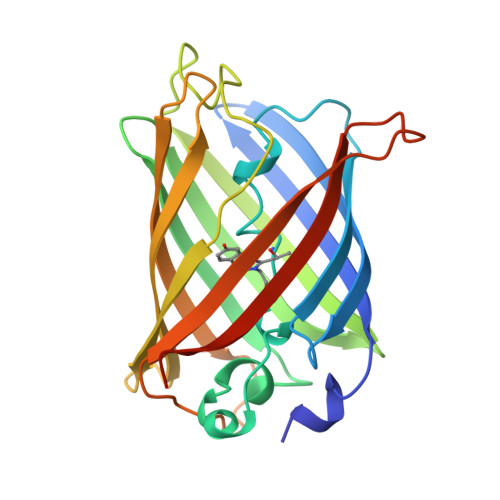Structural and spectral response of green fluorescent protein variants to changes in pH.
Elsliger, M.A., Wachter, R.M., Hanson, G.T., Kallio, K., Remington, S.J.(1999) Biochemistry 38: 5296-5301
- PubMed: 10220315
- DOI: https://doi.org/10.1021/bi9902182
- Primary Citation of Related Structures:
1C4F, 1EMG - PubMed Abstract:
The green fluorescent protein (GFP) from the jellyfish Aequorea victoria has become a useful tool in molecular and cell biology. Recently, it has been found that the fluorescence spectra of most mutants of GFP respond rapidly and reversibly to pH variations, making them useful as probes of intracellular pH. To explore the structural basis for the titration behavior of the popular GFP S65T variant, we determined high-resolution crystal structures at pH 8.0 and 4.6. The structures revealed changes in the hydrogen bond pattern with the chromophore, suggesting that the pH sensitivity derives from protonation of the chromophore phenolate. Mutations were designed in yellow fluorescent protein (S65G/V68L/S72A/T203Y) to change the solvent accessibility (H148G) and to modify polar groups (H148Q, E222Q) near the chromophore. pH titrations of these variants indicate that the chromophore pKa can be modulated over a broad range from 6 to 8, allowing for pH determination from pH 5 to pH 9. Finally, mutagenesis was used to raise the pKa from 6.0 (S65T) to 7.8 (S65T/H148D). Unlike other variants, S65T/H148D exhibits two pH-dependent excitation peaks for green fluorescence with a clean isosbestic point. This raises the interesting possibility of using fluorescence at this isosbestic point as an internal reference. Practical real time in vivo applications in cell and developmental biology are proposed.
Organizational Affiliation:
Institute of Molecular Biology, Department of Physics, University of Oregon, Eugene 97403, USA.















